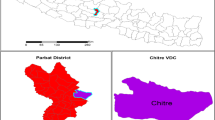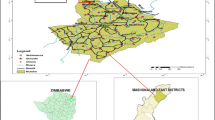Abstract
We examine how residents of Nawairuku, an interior village in Ra, Fiji, are experiencing and responding to recent social and ecological changes. An analysis of data collected using semi-structured interviews with 27 households reveals that household adaptability – the ability or capacity to adapt to the impacts of climatic variations – depends on access to livelihood assets. All households have access to social capital through familial networks, which lessens the burden of extreme weather events, namely cyclones and flooding. Households with access to tangible assets such as land and the equipment and resources to utilize it, together with intangible assets like motivation and knowledge are better positioned to adapt their agricultural practices to changing climatic conditions. Households headed by a capable individual were also better positioned to adapt. We conclude that remoteness promotes self-sufficiency and initiative, and access to livelihood assets influences household capacity to adapt.


Similar content being viewed by others

Notes
iTaukei = Indigenous Fijian people
Mataqali = A clan; primary Indigenous land-owning unit
Sevusevu = A traditional yaqona presentation made when something is requested
Talanoa refers to a process in which two or more people talk together, or where one person tells a story while the others listen (Nabobo-Baba 2006).
Bure = traditional Fijian house made of locally sourced natural materials (wood, vines, leaves)
This dataset was obtained from records kept by the turaga-ni-koro (village headman) who reported the damage to authorities for recovery compensation.
References
Australian Bureau of Meteorology, CSIRO (2011). Climate change in the Pacific: Scientific assessment and new research. In Volume 2: Country reports.
Barnett, J., Campbell, J. (2010). Climate Change and Small Island States: Power, Knowledge and the South Pacific. Earthscan, London, UK and Washington, DC, USA.
Berg, B.L., Lune, H. (2012) Qualitative Research Methods for the Social Sciences, 8th ed. Pearson, Boston, USA.
Bernard, H. R. (2012). Social Research Methods: Qualitative and Quantitative Approaches, SAGE Publications.
Berrang-Ford, L., Ford, J. D., and Paterson, J. (2011). Are We Adapting to Climate Change? Global Environmental Change 21(1): 25–33.
Brooks, N. (2003). Vulnerability, risk and adaptation: A conceptual framework. Tyndall Centre for Climate Change Research Working Paper 38, 1–16. University of East Anglia, Norwich, UK.
Carson, M., Köhl, A., Stammer, D., Slangen, A., Katsman, C., Van de Wal, R., Church, J., and White, N. (2016). Coastal Sea Level Changes, Observed and Projected during the 20th and 21st Century. Climatic Change 134(1–2): 269–281.
Chandra, A., and Gaganis, P. (2016). Deconstructing Vulnerability and Adaptation in a Coastal River Basin Ecosystem: A Participatory Analysis of Flood Risk in Nadi, Fiji Islands. Climate and Development 8(3): 256–269.
Davetta, S. (2017) Provinces and villages of Fiji. Ra Province, Suva, Fiji.
Department of Agriculture. (2014). Fiji farm management budget manual. Department of Agriculture, Suva, Fiji.
Dilling, L., Daly, M. E., Travis, W. R., Wilhelmi, O. V., and Klein, R. A. (2015). The Dynamics of Vulnerability: Why Adapting to Climate Variability will not Always Prepare us for Climate Change. Wiley Interdisciplinary Reviews: Climate Change 6(4): 413–425.
Ellis, F. (2000). The Determinants of Rural Livelihood Diversification in Developing Countries. Journal of Agricultural Economics 51(2): 289–302.
Farbotko, C., and Lazrus, H. (2012). The First Climate Refugees? Contesting Global Narratives of Climate Change in Tuvalu. Global Environmental Change 22(2): 382–390.
Fawcett, D., Pearce, T., Notaina, R., Ford, J. D., and Collings, P. (2018). Inuit Adaptability to Changing Environmental Conditions Over an 11-year Period in Ulukhaktok. Northwest Territories. Polar Record: 1–14.
Fazey, I., Pettorelli, N., Kenter, J., Wagatora, D., and Schuett, D. (2011). Maladaptive Trajectories of Change in Makira, Solomon Islands. Global Environmental Change 21(4): 1275–1289.
Fiji Department of Immigration (2017). Research permit. Fiji Department of Immigration, Suva. In Fiji.
Fiji Ministry of Communications (2016). Help for homes initiative - information background. Fiji government, Ministry of Communications, Suva. In Fiji.
Ford, J. D., Pearce, T., McDowell, G., Berrang-Ford, L., Sayles, J. S., and Belfer, E. (2018). Vulnerability and its Discontents: The Past, Present, and Future of Climate Change Vulnerability Research. Climatic Change: 1–15.
Fujieda, A., and Kobayashi, H. (2013). The Potential of Fijian Traditional Housing to Cope with Natural Disasters in Rural Fiji. Journal of Disaster Research 8(1): 18–27.
Hanich, Q., Wabnitz, C. C., Ota, Y., Amos, M., Donato-Hunt, C., and Hunt, A. (2018). Small-Scale Fisheries Under Climate Change in the Pacific Islands Region. Marine Policy 88: 279–284.
IPCC. (2018). Global Warming of 1.5°C, an IPCC special report on the impacts of global warming of 1.5°C above pre-industrial levels and related global greenhouse gas emission pathways, in the context of strengthening the global response to the threat of climate change, sustainable development, and efforts to eradicate poverty. Intergovernmental Panel on Climate Change, Incheon, South Korea.
Lata, S., and Nunn, P. (2012). Misperceptions of Climate-Change Risk as Barriers to Climate-Change Adaptation: A Case Study from the Rewa Delta, Fiji. Climatic Change 110(1–2): 169–186.
Maru, Y. T., Smith, M. S., Sparrow, A., Pinho, P. F., and Dube, O. P. (2014). A linked Vulnerability and Resilience Framework for Adaptation Pathways in Remote Disadvantaged Communities. Global Environmental Change 28: 337–350.
McCubbin, S., Smit, B., and Pearce, T. (2015). Where does climate fit? Vulnerability to Climate Change in the Context of Multiple Stressors in Funafuti, Tuvalu. Global Environmental Change 30: 43–55.
McDowell, J. Z., and Hess, J. J. (2012). Accessing adaptation: Multiple Stressors on Livelihoods in the Bolivian Highlands Under a Changing Climate. Global Environmental Change 22(2): 342–352.
Mortreux, C., and Barnett, J. (2009). Climate change, migration and adaptation in Funafuti, Tuvalu. Global Environmental Change 19(1): 105–112.
Nabobo-Baba, U. (2006) Knowing and Learning: An Indigenous Fijian Approach. Institute of Pacific Studies, University of the South Pacific, Suva, Fiji.
Nabobo-Baba, U. (2008). Decolonising Framings in Pacific Research: Indigenous Fijian Vanua Research Framework as an Organic Response. Alternative 4(2): 140–154.
NASA. (2016). Tropical Cyclone Winston Slams Fiji. NASA, Houston, Texas, USA. URL https://earthobservatory.nasa.gov/NaturalHazards/view.php?id=87562
Nelson, G.C., Rosegrant, M.W., Koo, J., Robertson, R., Sulser, T., Zhu, T., Ringler, C., Msangi, S., Palazzo, A., Batka, M. (2009) Climate Change: Impact on Agriculture and Costs of Adaptation (volume 21). International Food Policy Research Institute.
Nolet, E. (2016). Are you prepared?’ Representations and Management of Floods in Lomanikoro, Rewa (Fiji). Disasters 40(4): 720–739.
Nurse, L. A., McLean, R. F., Agard, J., Briguglio, L. P., Duvat-Magnan, V., Pelesikoti, N., Tompkins, E., and Webb, A. (2014). Small Islands. In Field, C., Barros, V., Dokken, D., Mach, K., Mastrandrea, M., Bilir, T., Chatterjee, M., Ebi, K., Estrada, Y., Genova, R., Girma, B., Kissel, E., Levy, A., MacCracken, S., Mastrandrea, P., and White, L. (eds.), Small islands. In: Climate Change 2014: Impacts, Adaptation, and Vulnerability. Part B: Regional Aspects. Contribution of Working Group II to the Fifth Assessment Report of the Intergovernmental Panel on Climate Change, Cambridge University Press, Cambridge and New York, pp. 1613–1654.
O’Brien, K., Leichenko, R., Kelkar, U., Venema, H., Aandahl, G., Tompkins, H., Javed, A., Bhadwal, S., Barg, S., and Nygaard, L. (2004). Mapping Vulnerability to Multiple Stressors: Climate change and Globalization in India. Global Environmental Change 14(4): 303–313.
Pearce, T. D., Ford, J. D., Laidler, G. J., Smit, B., Duerden, F., Allarut, M., Andrachuk, M., Baryluk, S., Dialla, A., Elee, P., Goose, A., Ikummaq, T., Joamie, E., Kataoyak, F., Loring, E., Meakin, S., Nickels, S., Shappa, K., Shirley, J., and Wandel, J. (2009). Community Collaboration and Climate Change Research in the Canadian Arctic. Polar Research 28(1): 10–27.
Pearce, T., Smit, B., Duerden, F., Ford, J. D., Goose, A., and Kataoyak, F. (2010). Inuit Vulnerability and Adaptive Capacity to Climate Change in Ulukhaktok, Northwest Territories, Canada. Polar Record 46(2): 157.
Pearce, T., Currenti, R., Mateiwai, A., and Doran, B. (2018). Adaptation to Climate Change and Freshwater Resources in Vusama Village, Viti Levu, Fiji. Regional Environmental Change 18(2): 501–510.
Reed, M., Podesta, G., Fazey, I., Geeson, N., Hessel, R., Hubacek, K., Letson, D., Nainggolan, D., Prell, C., and Rickenbach, M. (2013). Combining analytical frameworks to assess livelihood vulnerability to climate change and analyse adaptation options. Ecological Economics 94: 66–77.
Robinson, S.-a. (2017). Mainstreaming Climate Change Adaptation in Small Island Developing States. Climate and Development: 1–13.
Smit, B., and Wandel, J. (2006). Adaptation, adaptive capacity and vulnerability. Global Environmental Change 16(3): 282–292.
Stocker, T., Qin, D., Plattner, G., Tignor, M., Allen, S., Boschung, J., Nauels, A., Xia, Y., Bex, V., Midgley, P. (2013) IPCC, 2013: Climate Change 2013: The Physical Science Basis. Contribution of Working Group I to the Fifth Assessment Report of the Intergovernmental Panel on Climate Change, 1535 pp. Cambridge University Press, Cambridge and New York.
Sutherland, K., Smit, B., Wulf, V., and Nakalevu, T. (2005). Vulnerability in Samoa. Tiempo 54: 11–15.
Taylor, M. (2013). Climate change, relational vulnerability and human security: Rethinking sustainable adaptation in agrarian environments. Climate and Development 5(4): 318–327.
Tompkins, E. L., and Adger, W. N. (2005). Defining response capacity to enhance climate change policy. Environmental Science and Policy 8(6): 562–571.
Woodward, A., Hales, S., and Weinstein, P. (1998). Climate Change and Human Health in the Asia Pacific Region: Who Will Be Most Vulnerable? Climate Research 11: 31–38.
Acknowledgements
Vinaka vakalevu to the people of Nawairuku for their wonderful hospitality, generosity and support for this research. Thank you to those who shared your knowledge, experiences, stories and insights that are the heart of this paper. Thank you Teresa and Danny Rietberg for introducing us to Nawairuku and for your continued support of the research. Thank you, Lui Manuel, Nadroga-Navosa Provincial Council and Jeremy Hills, University of South Pacific (Suva campus), for your partnership and in-country support. The contributions of Professor Roy Sidle, Dr. Christine Jacobson and Dr. Vikki Schaffer, and members of the Environmental Change Research Group in the Sustainability Research Centre at the University of the Sunshine Coast, notably Eric Lede, Mathew Brown, Genevieve Lalonde, David Fawcett, Rachele Wilson and Kerrie Pickering, are also acknowledged. Thank you to Marie Puddister for Fig. 1.
Funding
This research was carried out with the aid of an Australian Government Research Training Program Scholarship awarded to Currenti and the University of the Sunshine Coast Fellowship program (Pearce).
Author information
Authors and Affiliations
Corresponding author
Ethics declarations
Ethical Approval
The research was undertaken with the agreement of the village of Nawairuku and the research was licensed by the Fiji Department of Immigration (#I7497899). Study protocols were approved by the Human Research Ethics Boards at the University of the Sunshine Coast (A/15/751) and University of the South Pacific, Suva, Fiji.
Conflict of Interest
The authors declare that they have no conflict of interest.
Additional information
Publisher’s Note
Springer Nature remains neutral with regard to jurisdictional claims in published maps and institutional affiliations.
Electronic supplementary material
ESM 1
(DOCX 22 kb)
Rights and permissions
About this article
Cite this article
Currenti, R., Pearce, T., Salabogi, T. et al. Adaptation to Climate Change in an Interior Pacific Island Village: a Case Study of Nawairuku, Ra, Fiji. Hum Ecol 47, 65–80 (2019). https://doi.org/10.1007/s10745-019-0049-8
Published:
Issue Date:
DOI: https://doi.org/10.1007/s10745-019-0049-8



